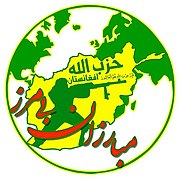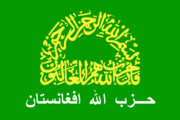Hezbollah Afghanistan is a Shia Islamist political party in Afghanistan. It was originally founded in 1980 as a rebel group and part of the Tehran Eight, it fought with Iranian support in the Soviet–Afghan War. In 2005, it became a legal party, and in the 2010s it developed close connections with Liwa Fatemiyoun, a paramilitary force organized by Iran.
Hezbollah Afghanistan حزب الله أفغانستان | |
|---|---|
 | |
| Secretary-General | Ahmad Ali Ghordarwazi[1][2] |
| Founder | Ahmad Ali Ghordarwazi[3] |
| Founded | 1980 (as rebel group)[3] 2005 (registered as legal party in Afghanistan)[1] |
| Associated group | Liwa Fatemiyoun[4] |
| Ideology | Afghan Shiite minority rights Shia Islamism[3] Khomeinism[3] |
| Party flag | |
 | |
History edit
In course of the Iranian Revolution of 1978/79, various radical grassroots groups emerged at Iranian universities. One of these, the "Hezb'ollahi", was characterized by the Time as a far-right religious fundamentalist movement that gave Ruhollah Khomeini "unquestioning obedience".[5] Following the Iranian Revolution, Iran began to establish several groups associated with the name "Hezbollah" in Afghanistan. The country funded and armed various insurgent groups, both Shiite as well as Sunni ones, as they fought in the Soviet–Afghan War.[6][7][8]
The first Afghan group officially known as "Party of Allah" ("Hezbollah" or "Hezbe Allah") was founded in 1980,[3] years before the better known Lebanese Hezbollah.[9] This Afghan Hezbollah was led by Qari Ahmad Ali, a cleric who hoped to become the "spiritual leader of the Shiites of Afghanistan".[3] The party was headquartered in Mashhad, with party branches based in the Iranian cities of Tehran, Nishapur, Zabol, Zahedan, and Geyebad. Its armed wing reportedly fielded 4,000 militants who fought against the Democratic Republic of Afghanistan (DRA) in the provinces of Herat, Farah, Nimruz, Ghor, Bamyan, Uruzgan, and Kandahar. The Afghan Hezbollah was reportedly known for its "brutality toward supporters" of the DRA.[3]
The group was first registered as a legal party under the name "Hezbollah Afghanistan" in the Islamic Republic of Afghanistan in 2005,[1] and remained a largely marginal force in Afghan politics.[4] According to researcher Phillip Smyth, Hezbollah Afghanistan "incorporated" with Liwa Fatemiyoun, an Afghan Shia paramilitary group fielded by Iran, at some point before 2014. Smyth noted that the two groups had considerable overlap in ideology and members.[4] In the next years, some sources such researcher Oved Lobel continued to regard Liwa Fatemiyoun and Hezbollah Afghanistan as separate, albeit closely connected organizations,[7] whereas others such as Arab News and Jihad Intel began to treat Hezbollah Afghanistan as synonymous with Liwa Fatemiyoun.[10][11] Researcher Michael Robillard called Liwa Fatemiyoun a "branch of Hezbollah Afghanistan".[12] As Liwa Fatemiyoun fought in the Syrian civil war, Hezbollah Afghanistan reportedly forged "obscure links" with Lebanese Hezbollah.[13]
After the 2021 Taliban offensive overthrew the Islamic Republic of Afghanistan, replacing it with an Islamic Emirate, Hezbollah Afghanistan leader Ahmad Ali declared that his party did not oppose the Taliban. According to him, the new government had assured him that Afghan Shiites would not be discriminated against. He also voiced his opinion that the Islamic Republic had failed in keeping Afghanistan stable and safe, and that the Islamic Emirate would improve the security situation.[2]
Organization and ideology edit
Since 1980, Hezbollah Afghanistan has been led by Qari Ahmad Ali Ghordarwazi (alternatively transliterated "Kari Ahmad Yakdaste" alias "one-armed Kari").[3][8][2] Hezbollah Afghanistan has traditionally been rooted in Shia Islamism and was supposed to spread the ideas of the Iranian Revolution.[3] In 2021, Qari Ahmad Ali declared that his party was opposed to religious discrimination in Afghanistan.[2]
References edit
- ^ a b c "فهرست کامل احزاب سیاسی افغانستان". BBC Persian. 13 July 2009. Retrieved 18 May 2022.
- ^ a b c d "حزب الله افغانستان: با آمدن طالبان نگران تأمین امنیت عاشورا نیستیم/ تکفیریها در نظام جدید به اهداف خود نمیرسند". Tasnim News. 19 August 2021. Retrieved 18 May 2022.
- ^ a b c d e f g h i "DOSSIERS OF POLITICAL PARTIES INTENT ON EXPORTING AN ISLAMIC REVOLUTION". Wilson Center. 1999. Retrieved 18 May 2022.
- ^ a b c Phillip Smyth (3 June 2014). "Iran's Afghan Shiite Fighters in Syria". Washington Institute for Near East Policy. Retrieved 18 May 2022.
- ^ "Nation: From the Campus to the Street". Time. 17 December 1979. Retrieved 18 May 2022.
- ^ Ari Heistein; James West (20 November 2015). "Syria's Other Foreign Fighters: Iran's Afghan and Pakistani Mercenaries". National Interest. Retrieved 18 May 2022.
- ^ a b Oved Lobel (16 November 2018). "Afghanistan: The Forgotten Front Against Iran". aijac.org. Retrieved 18 May 2022.
- ^ a b David Rohde (27 December 2006). "Iran Is Seeking More Influence in Afghanistan". New York Times. Retrieved 18 May 2022.
- ^ "Who Are Hezbollah?". BBC News. 21 May 2008. Retrieved 15 August 2008.
- ^ Majid Rafizadeh (9 September 2021). "Afghan chaos an opportunity for Iranian regime". Arab News. Retrieved 18 May 2022.
- ^ "Liwa al-Fatemiyoun". Jihad Intel. Archived from the original on 4 August 2018. Retrieved 4 August 2018.
- ^ Robillard 2021, p. 175.
- ^ Alami 2017, p. 26.
Works cited edit
- Alami, Mona (March 2017). "Hezbollah's Military Involvement in Syria and its Wider Regional Role" (PDF). Dirasat (21). Riyadh: King Faisal Center for Research and Islamic Studies. ISBN 978-603-8206-25-6.
- Robillard, Michael (2021). "Syria". In Paul Burke; Doaa' Elnakhala; Seumas Miller (eds.). Global Jihadist Terrorism: Terrorist Groups, Zones of Armed Conflict and National Counter-Terrorism Strategies. Northampton: Edward Elgar Publishing. pp. 167–187. ISBN 978-1-80037-129-3.